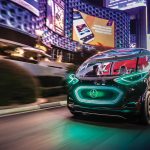Electric future for South America

The profitability of commercial vehicle sales is expected to decline dramatically, while after-sales services increase over the next decade. However, electric vehicles (EVs) could be a saving grace for original equipment manufacturers (OEMs) operating in South America
The McKinsey Centre for Future Mobility, a division of McKinsey & Company, found in its January study titled: A regional view of truck industry profit pools, that after-sales profits will grow dramatically in the next decade. While OEM profits are expected to grow at 2,9 percent per annum, global after-sales profit is expected to increase by 3,4 percent per annum.
Global OEM profits in 2030 are expected to be around €16,1 billion (R247 billion), while global after-sales profit is expected at about €7,1 billion (R109 billion). Mature markets, such as North America, are expected to be the most profitable regions. However, nearly half of the profit growth is expected to come from after-sales services.
The increase in after-sales service profits are affected by increased emission regulation, an increase in EVs and price pressures. In his article for news website Freight Waves, John Paul Hampstead quotes the report: “We believe increased competition, industry consolidation, higher emission standards and the replacement of diesel trucks by EVs will reduce the global truck profit pool by €3,9 billion (R59 billion) through 2030.
“Combined with the expected positive €3,2 billion (R49 billion) profit expansion, due to volume increases and structural shifts, the net impact of the two market developments will shrink the global profit pool by €600 million (R9 billion) in 2030. Consequently, OEMs cannot rely on the market to ‘grow’ their way to higher profitability. Instead, they need to focus on addressable action areas.”
These include operational efficiency and new opportunities such as technology trends. According to the report, the price pressure will make truck sales in emerging markets barely profitable. However, Brazil is forecasted to experience some of the fastest growth in volume of new trucks with an annual growth rate of 6,2 percent.
Outside of Brazil, McKinsey & Company foresees very few profit opportunities in South America; with the overall revenue expected to grow from €3,7 billion (R56 billion) to €5,7 billion (R87 billion) by 2030.
Profitability is expected to decline from 2,1 percent to 1,4 percent. Although OEMs face poor sales projections for South America, EVs could offer an alternative revenue stream.
Chile was one of the most recent South American countries to introduce EVs. In December 2018, Chile imported 100 electric buses from China to revolutionise its public transport system.
These buses will be used in the capital of Santiago, which has a notorious smog problem. The country’s ambitious plan also includes the roll out of electric scooters, cars, taxis and trucks for the mining industry.
According to the Energy Minister of Chile, Susana Jiménez, the Chilean government wants EVs to account for 40 percent of the country’s private fleet and 100 percent of the public transport by 2050. This puts Chile at the front of clean mobility in Latin America and among developing countries worldwide.
In an article for Business Live, Natalia A Ramos Miranda quotes President Sebastian Pinera: “Chile will be second only to China as a nation with the greatest quantity of electric buses in the world.” China currently runs 99 percent of the 385 000 electric buses on the road globally.
Santiago will have 200 buses in total. The Chilean ministry has also invested in a fleet of EVs. Chile is not alone in its plans for electric transport.
Mexico City has a growing electric scooter and bicycle market with plans to introduce between 300 and 500 electric buses. Meanwhile, Peru has reduced import tax on EVs and Colombia is converting the engines of public diesel buses to a (unspecified) cleaner engine.
According to Miranda, if buses and taxis in the 22 Latin American cities were replaced with EVs, about US$ 64 billion (R868 billion) in fuel would be saved and the carbon dioxide released would decline by 300 million tonnes by 2030. While the government might have the resources to invest in EVs, the costs are still too high for the average Chilean.
A BMW i3 – the model of EV bought by the Chilean ministry – costs around US$ 60 000 (R813 294) in Chile where the average monthly wage is US$ 410 (R5 557). The country also has only 40 public charging stations of which half are in the capital. One benefit in investing in EVs is that Chile is the second-largest producer of lithium – a key component in the batteries used in EVs.
It is the access to lithium that will also greatly impact on the growth of EV sales over the next few decades. The Bank of America Merill Lynch notes that the growth of EVs hinges on a handful of key metals, for instance lithium and cobalt. Access to these minerals can be greatly affected by the political unrest found in the developing countries where they are mined.
The Democratic Republic of Congo produces 62 percent of the global cobalt output, but also has a very fragile political environment. “Any major disruption to cobalt today would likely curb EV proliferation in the early 2020s,” the Bank of America Merrill Lynch warns. Interruptions in lithium supply could have a similar impact on the market. EVs are expected to capture 40 percent of global vehicle sales by 2030 before rising to 95 percent by 2050.
In addition to the investment in EVs in South America, plans are underway to build a bi-oceanic corridor. The transnational railway will link the Pacific and Atlantic Oceans over a 3 000-km route that will start at the port of Puerto Santos in Brazil and run to the Puerto de Ilo in Peru, crossing 1 700 km of Bolivian territory.
In an article for news website Railway Technology, Eva Grey writes: “If greenlit, the megaproject is expected to completely overhaul South America’s trade and political landscape. It also spells the end for the current monopoly that maritime shipments have on trade. Since its conception, several feasibility studies have already been completed and all three South American countries involved have greenlit the project.”
While there is no date set for the project, the secretary general of the Union of South American Nations, Ernesto Samper Pizano, hinted that seven million people and nearly 10 000 t of cargo will be transported in 2021. Other reports suggested the project will be realised only in 2025. Although the bi-oceanic corridor will make transporting commodities more affordable, it could further impact on vehicle sales in South America.
The corridor passes through some difficult terrain such as the Andes mountain slopes and Amazon forests. While studies are still being conducted, the project has already received some backlash for its potential impact on the environment. The corridor resembles the Interoceanic Highway, which made headlines for the deforestation of 680 000 acres of Amazonian rainforest.
Continued research into more affordable EVs might be key to ensuring profitable vehicle sales in most developing countries over the next decade, especially in the South American countries that are looking to an electric future.
Published by
Mariska Morris
focusmagsa




